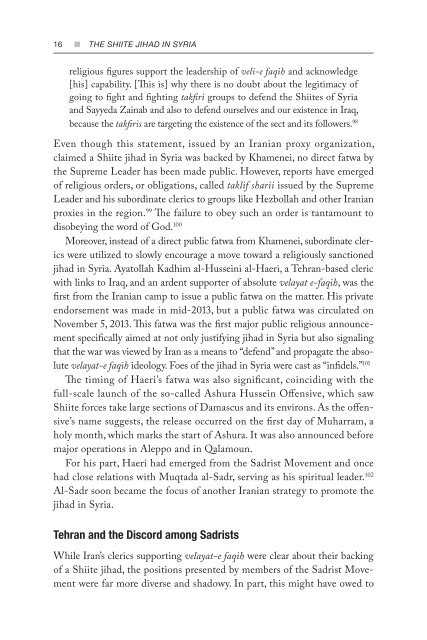You also want an ePaper? Increase the reach of your titles
YUMPU automatically turns print PDFs into web optimized ePapers that Google loves.
16 n <strong>THE</strong> <strong>SHIITE</strong> <strong>JIHAD</strong> <strong>IN</strong> <strong>SYRIA</strong><br />
religious figures support the leadership of veli-e faqih and acknowledge<br />
[his] capability. [This is] why there is no doubt about the legitimacy of<br />
going to fight and fighting takfiri groups to defend the Shiites of Syria<br />
and Sayyeda Zainab and also to defend ourselves and our existence in Iraq,<br />
because the takfiris are targeting the existence of the sect and its followers. 98<br />
Even though this statement, issued by an Iranian proxy organization,<br />
claimed a Shiite jihad in Syria was backed by Khamenei, no direct fatwa by<br />
the Supreme Leader has been made public. However, reports have emerged<br />
of religious orders, or obligations, called taklif sharii issued by the Supreme<br />
Leader and his subordinate clerics to groups like Hezbollah and other Iranian<br />
proxies in the region. 99 The failure to obey such an order is tantamount to<br />
disobeying the word of God. 100<br />
Moreover, instead of a direct public fatwa from Khamenei, subordinate clerics<br />
were utilized to slowly encourage a move toward a religiously sanctioned<br />
jihad in Syria. Ayatollah Kadhim al-Husseini al-Haeri, a Tehran-based cleric<br />
with links to Iraq, and an ardent supporter of absolute velayat e-faqih, was the<br />
first from the Iranian camp to issue a public fatwa on the matter. His private<br />
endorsement was made in mid-2013, but a public fatwa was circulated on<br />
November 5, 2013. This fatwa was the first major public religious announcement<br />
specifically aimed at not only justifying jihad in Syria but also signaling<br />
that the war was viewed by Iran as a means to “defend” and propagate the absolute<br />
velayat-e faqih ideology. Foes of the jihad in Syria were cast as “infidels.” 101<br />
The timing of Haeri’s fatwa was also significant, coinciding with the<br />
full-scale launch of the so-called Ashura Hussein Offensive, which saw<br />
Shiite forces take large sections of Damascus and its environs. As the offensive’s<br />
name suggests, the release occurred on the first day of Muharram, a<br />
holy month, which marks the start of Ashura. It was also announced before<br />
major operations in Aleppo and in Qalamoun.<br />
For his part, Haeri had emerged from the Sadrist Movement and once<br />
had close relations with Muqtada al-Sadr, serving as his spiritual leader. 102<br />
Al-Sadr soon became the focus of another Iranian strategy to promote the<br />
jihad in Syria.<br />
Tehran and the Discord among Sadrists<br />
While Iran’s clerics supporting velayat-e faqih were clear about their backing<br />
of a Shiite jihad, the positions presented by members of the Sadrist Movement<br />
were far more diverse and shadowy. In part, this might have owed to


